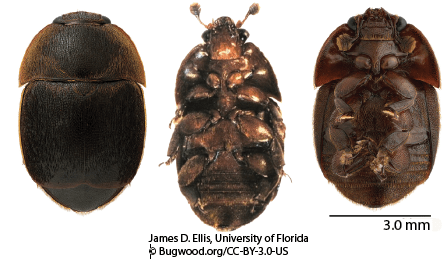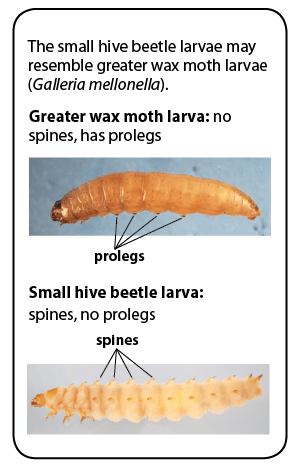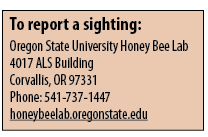The small hive beetle is an invasive and damaging pest of honey bee colonies. It has been occasionally observed in honey bee colonies in Oregon, but no significant damage from this beetle has yet been reported. It is not clear whether this beetle can thrive in Oregon’s soil and climatic conditions. Early detection, reporting, and monitoring of small hive beetle may help mitigate its establishment in this region.
Keep small hive beetle OUT of Oregon!
Learn them, watch for them, and report them!
The adults are:
- brown to black in color
- oval shaped
- about ¼ inch (5.7 mm) long (about one-third the size of a honey bee)
- stout, squat in shape
- no additional elongated segments of the other beetles
Where to find them:
- Cracks and crevices in colony
- Weak colonies
- Honey houses with stored honey supers
- Protein patties
Prevent SHB establishment!
- Keep strong colonies
- Promptly remove deadouts
- Extract honey immediately after harvest
- Do not feed protein patties during almond pollination
- Carefully inspect packages, nucs, queens purchased from areas with established SHB
- Watch for them, report them if you find them.
For more information:
The Small Hive Beetle: A Potential Pest in Honey Bee Colonies in Oregon (EM 9143)
Use pesticides safely!
- Wear protective clothing and safety devices as recommended on the label. Bathe or shower after each use.
- Read the pesticide label—even if you’ve used the pesticide before. Follow closely the instructions on the label (and any other directions you have).
- Be cautious when you apply pesticides. Know your legal responsibility as a pesticide applicator. You may be liable for injury or damage resulting from pesticide use.
© 2016 Oregon State University
Extension work is a cooperative program of Oregon State University, the U.S. Department of Agriculture, and Oregon counties. Oregon State University Extension Service offers educational programs, activities, and materials without discrimination on the basis of race, color, national origin, religion, sex, gender identity (including gender expression), sexual orientation, disability, age, marital status, familial/parental status, income derived from a public assistance program, political beliefs, genetic information, veteran’s status, reprisal or retaliation for prior civil rights activity. (Not all prohibited bases apply to all programs.) Oregon State University Extension Service is an AA/EOE/Veterans/Disabled.





